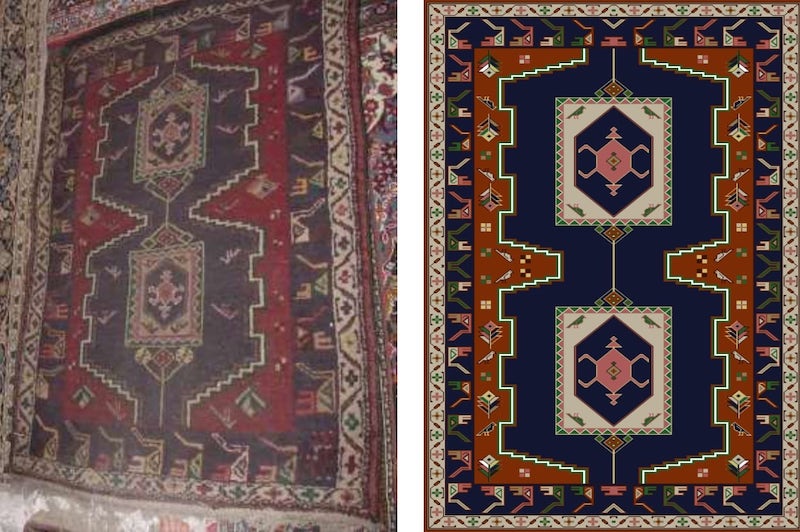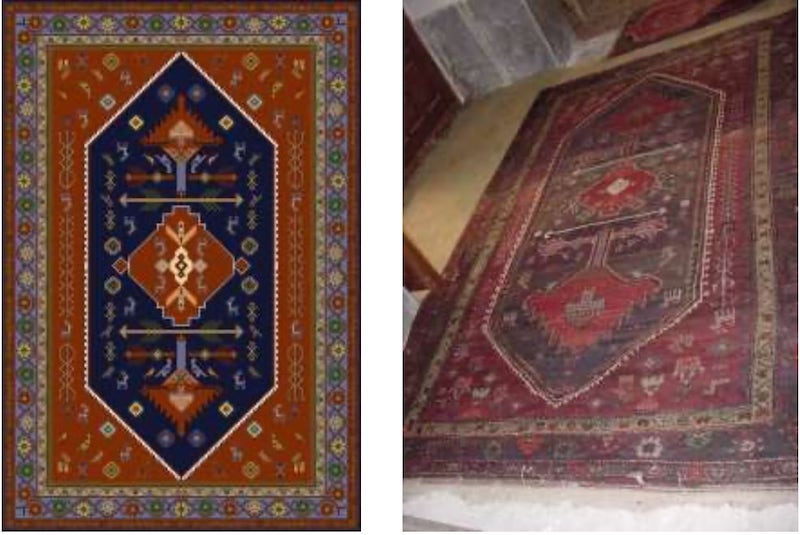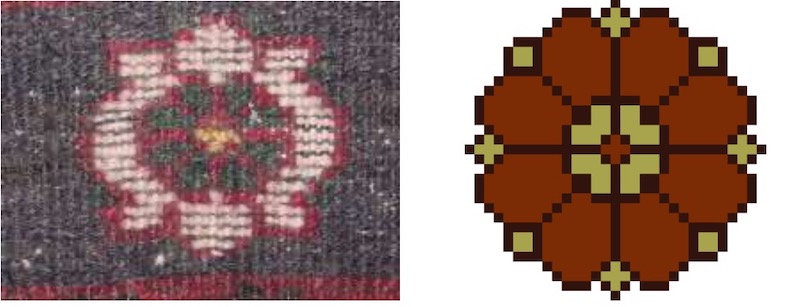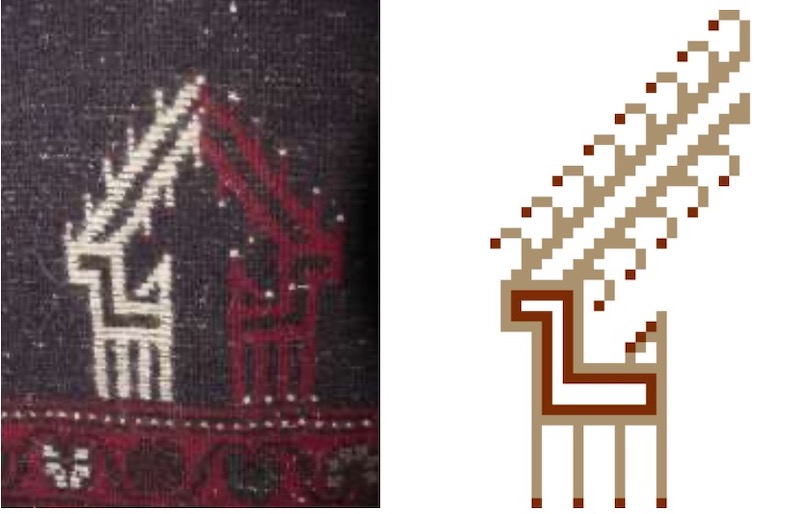Authors:
S.Ali Mojabi – Assistant Professor, Department of Art, Architecture and Urban Planning, Najafabad Branch, Islamic Azad University, Najafabad, Iran.
Zahra Fanaei – Assistant Professor, Department of Art, Architecture and Urban Planning, Najafabad Branch, Islamic Azad University, Najafabad, Iran.
Sayyed Bashir Abedini – B.S. in Carpet designing, Science & Arts University, Yazd, Iran.
Abstract
The present article is a field and documentary research based on available historical and pictorial resources to identify the design and image of Kelardasht carpet. To extract information in addition to the documentary study which is carried out by referring to written and unwritten materials, field research has been carried out by referring to old carpets, making pictures of them, and interviewing with some experienced people.
Finally, Kelardasht plans and designs have been identified by comparing the obtained data and pictures. The study of design, images and colors of Kelardasht carpet revealed that most of its designs have been forgotten and not woven anymore. However, because this carpet is untradable and it is not easy to reach the regions engaged in its weaving, the related designs have been left intact for a long time.
1- Introduction
The most famous hand-made carpet of north Iran including Gilan and Mazandaran provinces is Kelardasht hand-made carpet having evident signs of people’s culture and it is a reflection of a natural connection with God [1].
In Geography of Mazandaran province, Kelardasht is known for the thick-napped carpet in this area. In addition to carpet, felting and Sachin (a local handmade) are other hand-woven products of this region [2].
In this research, the remainder and old Kelardasht carpet have been identified and investigated. Because of the inappropriate roads, bad weather, unavailability to local places, field study was not possible and we have just conducted a documentary one.
In the west area of Kelardasht, there are Alam kouh & Takhte Soleyman, Ojabit hills, Gorg pass, Majl, Sardar Jungle and Barar jungles, among which only Ojabit hills are inhabitable. According to the local people and documentary studies, in the south and southeast of this area carpet- weaving has been scare.
In the northeast, there are Mazichal plain, Azou and Khachouni jungle, therefore most of the weavers are scattered in the north and east of the region.
Known carpets in this study have been obtained from mosques and old houses in Bazarsar, Makaroud, Pishempour, Ojabit, Rodbark, Kord Mahale, Kalenou, Hasan keif, shekarkouh. But figure 2 shows different parts of Kelardasht.
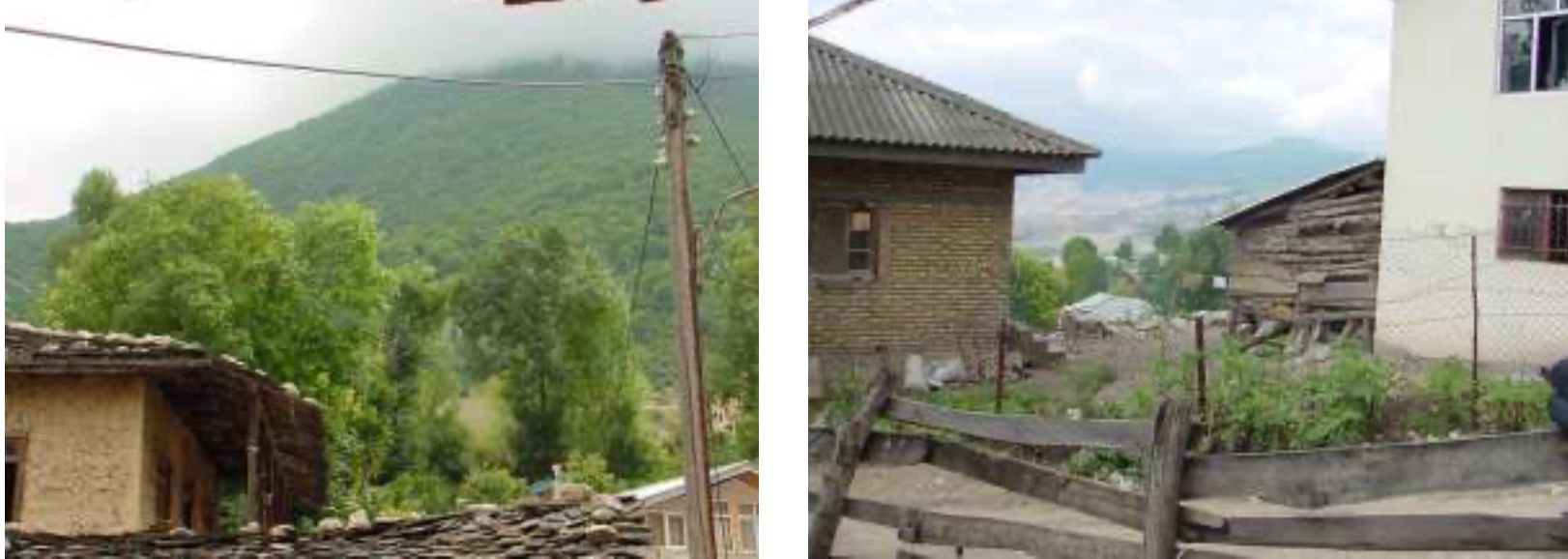
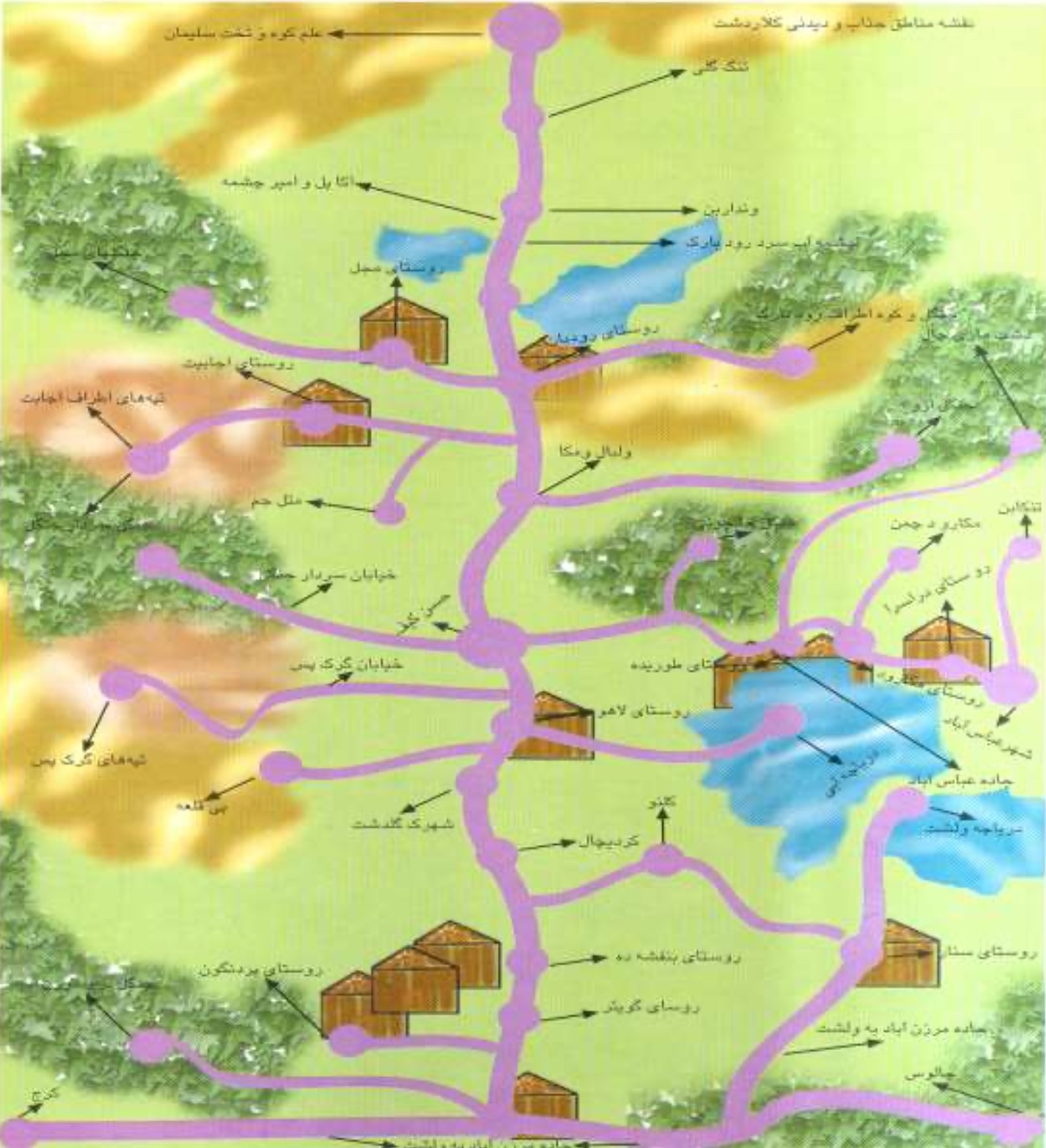
2- Kelardasht`s Geography
According to state divisions, Kolardasht is a part of Chalous. It is located in the west of Mazandaran province and 36 degrees and 29 minutes of north latitude, 51 degree, 6minutes of east longitude and its size is about 1509 square kms.
Kelardasht has three rural districts. The centrality of Kourdichal with a size about 600 square Kilometers includes a plain with 13 km length and 10 km width and is surrounded by mountains and jungles on the north foothills of Alborz Mount. Another rural district is Biroun Bashm that has 171 sq km size with the centrality of Tavir [8].
According to the headcount of 1996, Kelardasht has 140 villages, 42 villages are in Kelardasht, 35 villages are in Biroundasht and 63 are in Kouhestan. 31 villages have no residents and Kelardasht`s population is about 23097 [4].
Literally, Kelar is the name of a traditional city and an ancient castle. Yet “Kelar” in the Mazandaran local dialect means frog or toad and “lash” means very large marshy lands that is considered as the habitat of this animal and a lot of them could be found there. So many people believe Kelardasht`s name has come from these situations [6,5].
2-1- The Evolution of tribes Settled in Kelardasht
As it was mentioned, first residents in Mazandaran were ancient Tipouri tribes. When Aryans migrated to the north of Iran, these two groups started a war. Based on Aryans`view, demons were Satan and devil and regarding that Tipouri tribes knew Satan as a holly thing, therefore this cultural difference intensified the war.
After some years when the two groups were mixed, the first ancient tribes were formed in Kelardasht. With the beginning of the Mongol invasion to Iran, the first Kurd-speaking tribes migrated to this place. During Safavid era (11thcentury), in two separate stages, other Kurdish tribes and then Lors migrated to this area. Migration of Kurdish Shiite in Qajar dynasty has caused most of the residents to be Kurds [9,10].
2-2- commencement of carpet-weaving in Kelardasht:
There are three different relevant theories. The first theory says that Kelardasht ancient residents learnt carpet weaving through the relationship with north Sekaie tribes and then by the arrival of Aryans to this place and this trend continued from generation to generation. So some believe that one of the noblest carpets has been woven in this area. For the geographical reason, as well as being coarse-woven and thick-napped and as the result of lack of export and being untradeable, this carpet has gone through little changes in terms of design and image [11].
It is likely that because of cold weather, the number of house wives and suitable raw materials for carpet-weaving, this art in Kelardasht has an old background. If it is true, Kelardasht carpet should be sought in the famous area of Tabarestan in three and four centuries or we can attribute its backgrounds to southern regions of Alborz foot such as Taleghan carpet [12].
On the other hand, the second theory claims that Kelardasht carpet’s background goes back to 13th century and because it has common designs and images with Kurdish carpets they are attributed to Kurds migration. The geometric structure of Kelardasht has considerable similarities to old Sanandaj carpets [13].
The last theory about the beginning of carpet weaving in this area is a combination of two former theories. They believe carpet weaving has a long background in Kelardasht and width arrival of Kurds to this area, carpet has been affected by Kurd weaving culture and designs and today it is a part of Kurd geographical carpet-wearing art. Unfortunately, no Kelardasht carpet has been left from before 13th century making it possible to reach an acceptable and documentable result [14].
3- Technical Characteristics of Kelardasht carpet
Kelardasht carpet is a carpet with knot counts fewer than 20 (average between 15 and 20), knot in 7 cm with cotton warp and wool weft. In the beginning of 13th century, the authenticity of Kelardasht carpet was indicative of a full-woolen carpet but it has been changed over time [16].
The Consumed wool in Kelardasht carpet is native wool that is a product of mixing Zol with Mongolian sheep that was spun by hand in the recent years they use imported woolen yarn. Woolen yarns are 3/2 to 5/2 m that have a little spun and many un-harmonies. Cotton yarns are spun and used 12 to 15 folds [16].
Natural colourific used in Kelardasht carpet include mulberry`s leaves, Kash’s leaves, Al, Nil, Roans leaves and trunks, red seed walnut’s shell. Among them, mulberry, and Al’s leaves are special colourific and others are imported colors [15,18].
Kelardasht carpet is woven with Turkish knot, without grab, with double wefts, half Lool on Persian fix looms that doesn’t need anybody to be under. Weaving tools are Persian kind and warping after warp winder is placed on loom. In this area it is not customary to weave big carpets and a 6 m carpet with two or four weavers lasts about 30 to 45 days[17,18].
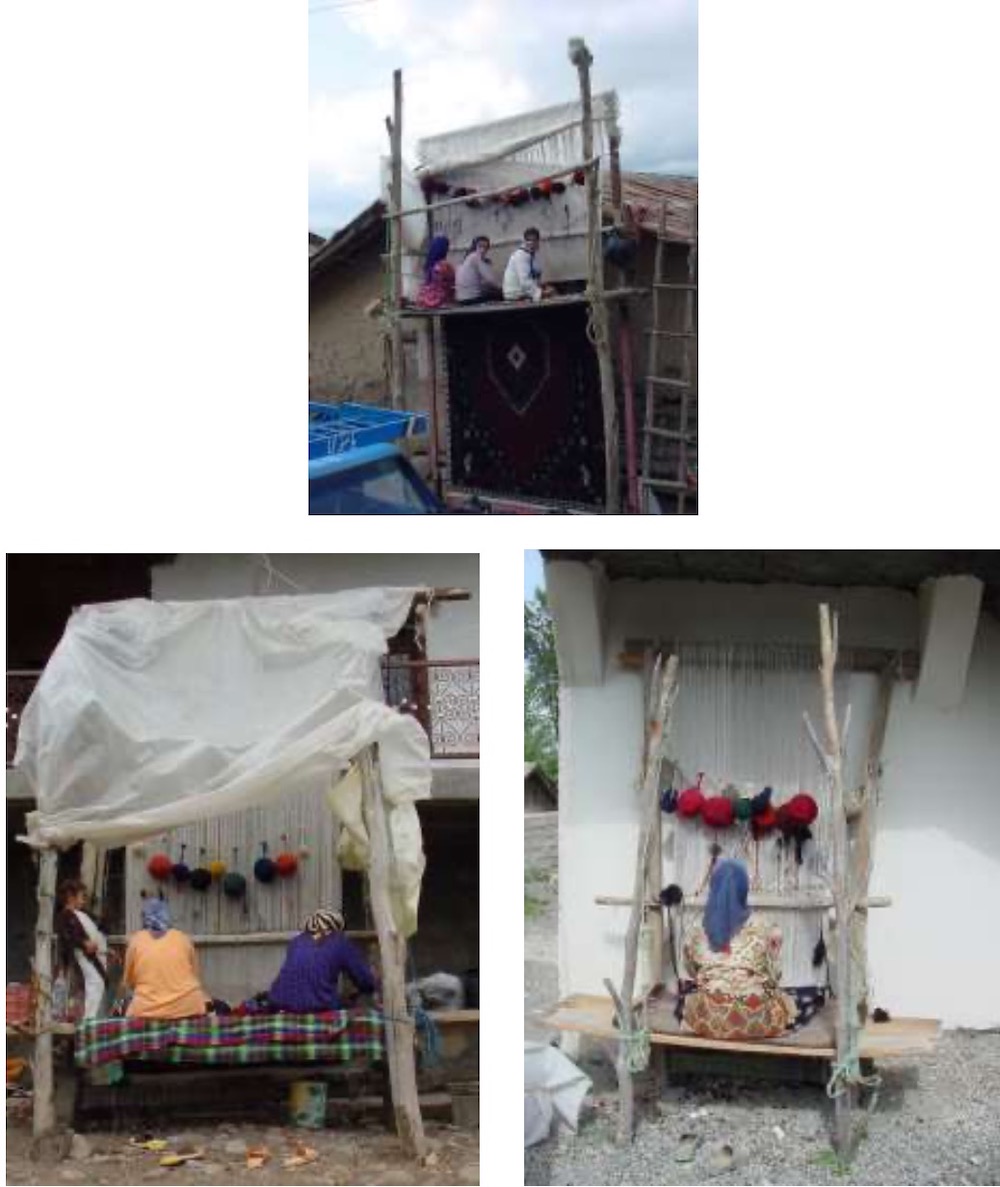
5- Designs and Images of Kelardasht Carpet
Kelardasht designs are completely subjective and do not have any designs. These designs are classified according to the different concepts. The simplest modes of classification are:
a- Box designs
b- Forest designs
c- concrete designs
d- Abstract designs (come from city culture)
5-1-Box designs:
Box designs are the oldest designs. An esthetic interpretation says, old ice-boxes called box have been the most fundamental part of girls’dowry. It was put in a special place to keep her dowry’s tiny decorative valuable things. It was a custom to put icebox in a place so that all of inhabitants and guests can see it in order to show the worth of the bride’s dowry.
Another custom was that bride put a samovar in this box and took it as an important part of her dowry. This attitude toward decoration and arrangement of the house has been used in carpet weaving in abstractive way. So in box designs, both box and abstractive samovar are woven in the Middle medallion and in the box.
It is said that when bride gives a birth, she puts the baby in the cradle and fasten a rope to his/her feet, and then move her/ him to sleep. So all over the carpet you can see a rope that connects margins to the rest representing this carpet.
All the carpet is red that shows Mother’s love. This love is at home. Margins are dark blue to cast an evil eye and take away home from bad things.
Such designs represent that whatever comes in the original context is somehow representing woman’s feeling and art to her husband, attracting his attention and reminding her endless love to him.
For example, chessboard flowers called Halvaghajou that is a kind of candy cooked with honey and butter shows woman’s cooking art and her love to her husband (Figs 4&17). Other field flowers woven in the carpet have come from women’s woolen socks.
In these designs, the woman prefers home and her family. For example, weaving dog’s claw in the margin is locally Vargehchang. It shows that the house is guarded by a dog (Fig 9) or fox`s tail around the field and margin show that (Fig 4) the house is taken away from this animal and it can never come to ground.
5-2- Forest designs
These designs are the most common ones in the kelardasht carpet. This design at least has medallions which are separated from each other with a festoon design. Festoon design represents very height mountains. Beside these designs, there are stair-like designs showing River which runs from the mountain (Fig 5). In these designs, different kinds of animals and plant motifs are used. Different birds like sparrow, hoopoe, butterfly, eagle, and hawk are
animal designs and they are divided into two wild and domestic parts. Among bird motifs are only peacock whose tails are pointing upward (Fig 7).
Deer (Fig 10), goat (Fig 11), bear (Fig 9), or different signs on the snow or land are considered main animal motifs. Wild animals and pets are forbidden by Islamic culture, so never used in Kelardasht carpet directly. Only their traces are observed in these designs such as Vargechang meaning dog’s trace or fox`s tail. Dar (tree) and AV (running water) designs are among plant motifs. Fig 12 shows one of the most beautiful jungle designs in Kelardasht. This is called Varsangoli (Varsan means rolling pin) and shows bread that it is became soft with a rolling pin in order to be used at safe environment of home.
5-3- concrete designs
There are many different designs in Kelardasht which are very rare today. Some of them have medallion and some do not have any. Most of these designs are formed by repeating a specific and arrangement of a motif or design. Shemlei (scale), velvet (plant), Mazleghani, Pempal Naghshe (Pempal shows light and lightening symbol and has been very holly in this area) are among these designs. Figures 13 and 14 are recovered samples of two Shemlei and velvet flower designs. Both of these designs are formed by the repetition of specific motif throughout the carpet context and ground.
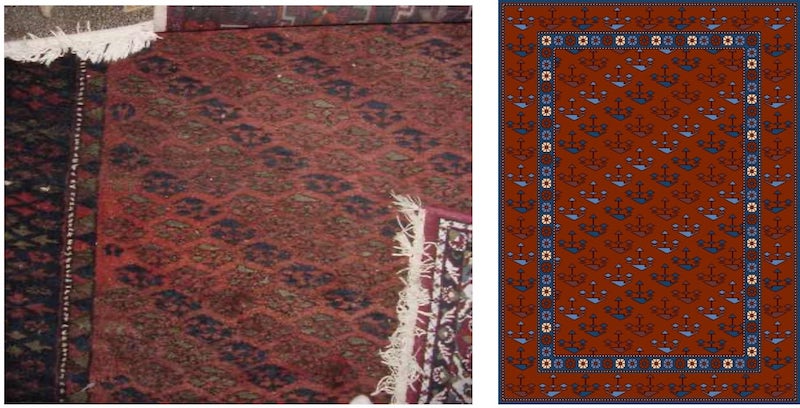
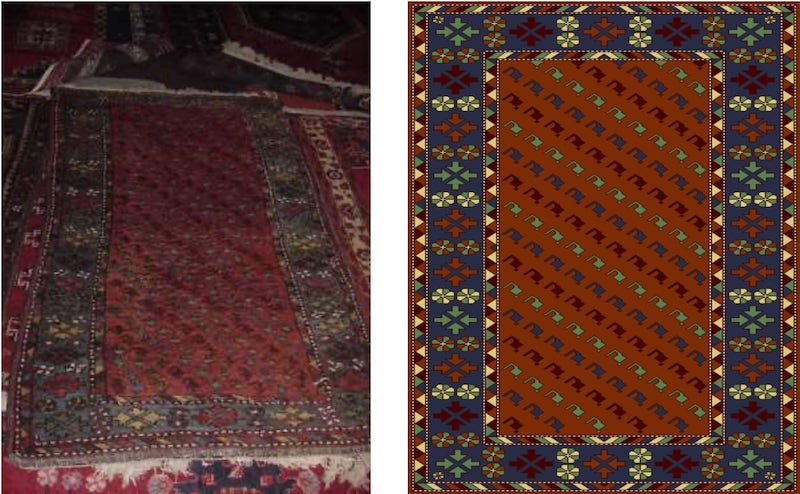
5-4- Abstract design resulting from civic culture
These designs have been resulted from observing civil carpet-weaving and are the latest designs. Tehrani design is a completely abstractive design that which is woven by a weaver from civil carpet’s designs that is perhaps one of the best abstractive designs in Kelardasht (Fig 14). These represent the weaver’s creative mind not so popular in this area. These designs are derived completely from jungle carpets but jaggy jungle or mountain structures are replaced by unknown Eslimi designs.
Corner making without paying attention to the original structure of Kelardasht carpet is another interesting matter of these designs.

6-2- Classification of motifs in used Kelardasht carpet according to the form and framework
According to form and framework of motifs used in Kelardasht they can be divided into five different groups.
A. Squares
Shapes with peripheral lines around a square are placed in this group (like Fig 16- Halvaghajal)

B. Hexagon or octagon
Shapes with peripheral line with six or eight angles are placed in this group (Fig 17- Majame motif-is a kind of tray used for lunch)
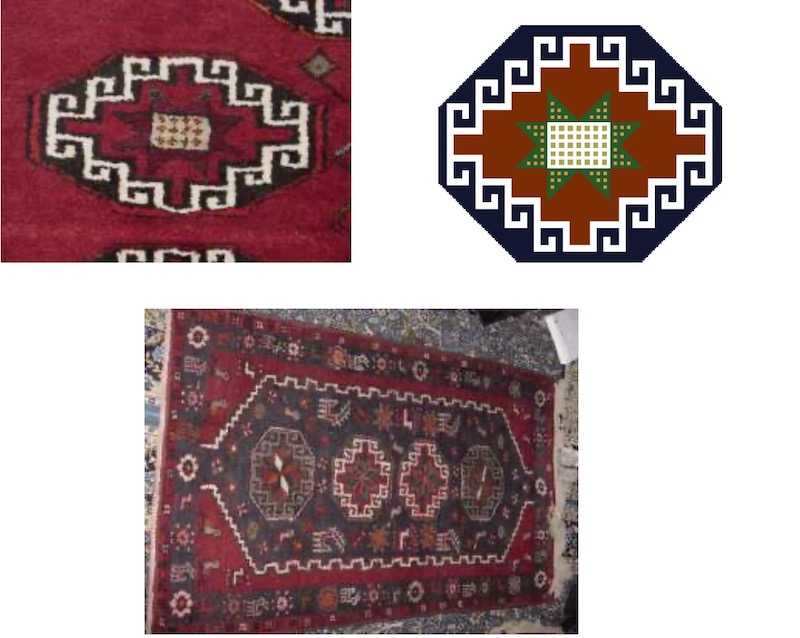
C. Circles
Shapes whose total peripheral forms are based on one central point (Fig 18-vargechang motif)

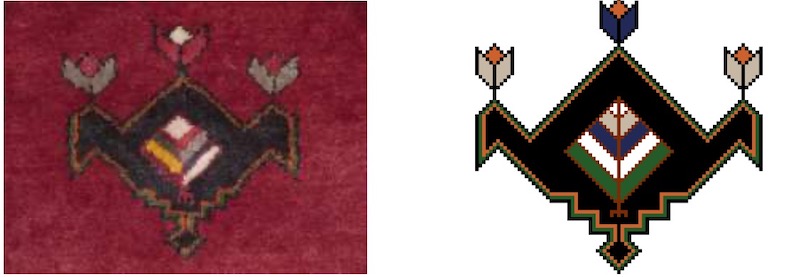
6-3- Thematic Classification of Motifs used in Kelardasht Carpet)
Abstract designs used in Kelardasht carpet can be classified according to thematic concepts. In this regard, motifs used in Kelardasht carpets are classified in five groups.
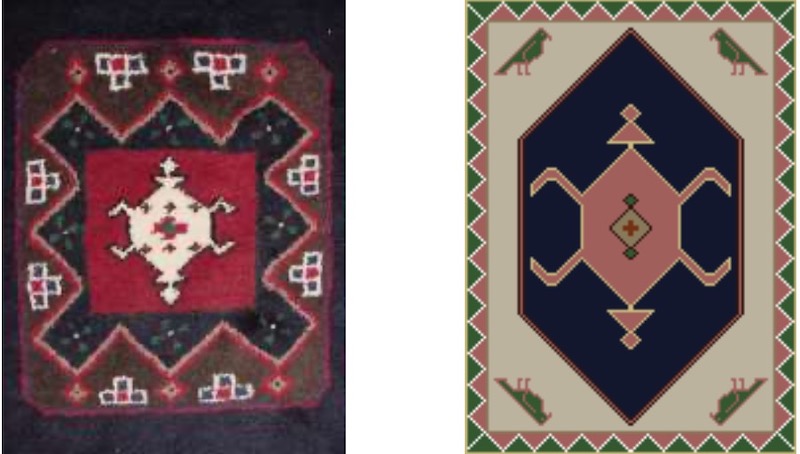
A: animal motifs (butterfly motif-Fig 24)
Animal motifs are three different groups. First group is bird motifs like sparrow or butterfly. These motifs in women’s opinion are regarded as fortune, the beginning of the new season and morning call. Another group of animal motifs derived from wild animals like deer or beer. Last motifs represent guarding concept from home like Pichachang Vargechang or fox’s tail.
In this group of abstracts the animal in never shown, but it is woven for its importance and usefulness of guarding the family environment.
E: Frames

B- Human motifs (woman motif-Fig 25)
This motif is not used a lot. It cannot be certainly said but in old carpets human motifs such as women or kids are not seen.
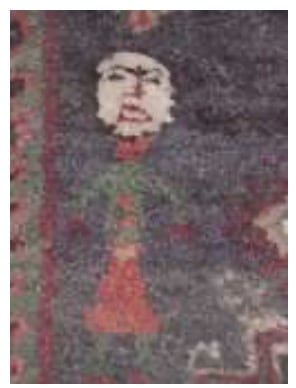
C: Plant motifs (Fig 26)
These motifs are 3 groups: flowers, mountains, and rivers. Mountain and river are always used for separating medallions inside field or margin of the field.
D: abstract motifs of things surrounding life
These motifs are very various and they are from living things (Pampal motif Fig. 27 Lampa motif picture 28) Women’s decoration materials (Valzolfak: necklace) cooking utilities (Dori: candy tray, lohdeser: pot lid or samovar), food (Halva Ghachal a kind of local candy, se kilo goshtag= meat Sack Mah: Khash: fish’s bone), spinning and weaving materials (Shane milk: warp spinning, Meghrazkoul scissors) home materials(Kerish= mat, Maghs kanded= hive, Shamel: scale) light things (Pampal, Lampa) are in these groups.
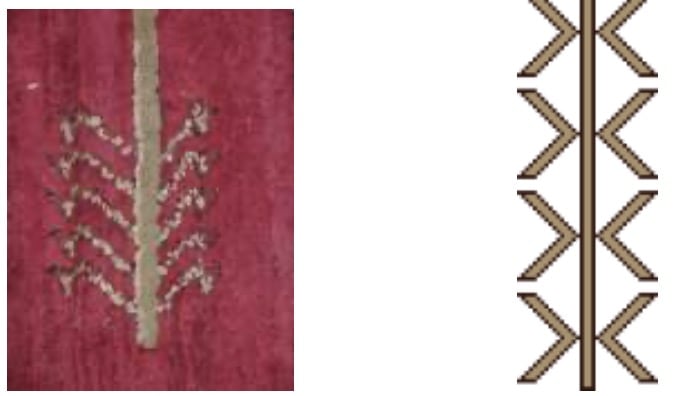
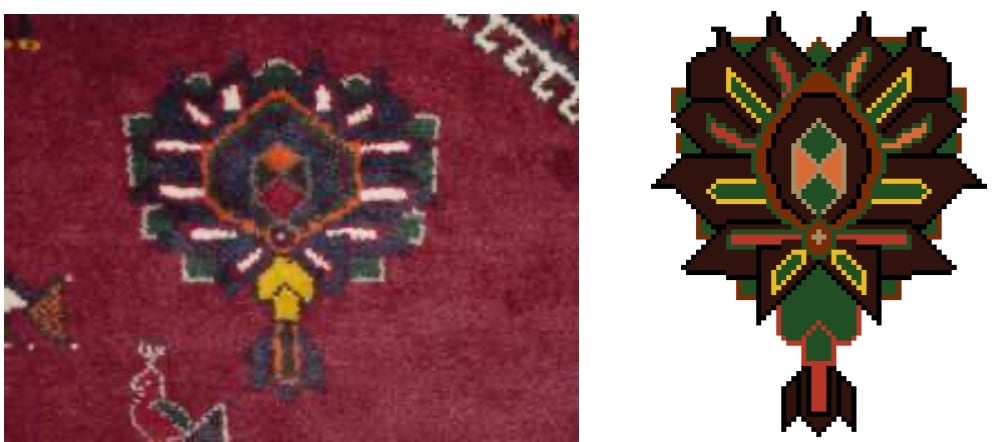
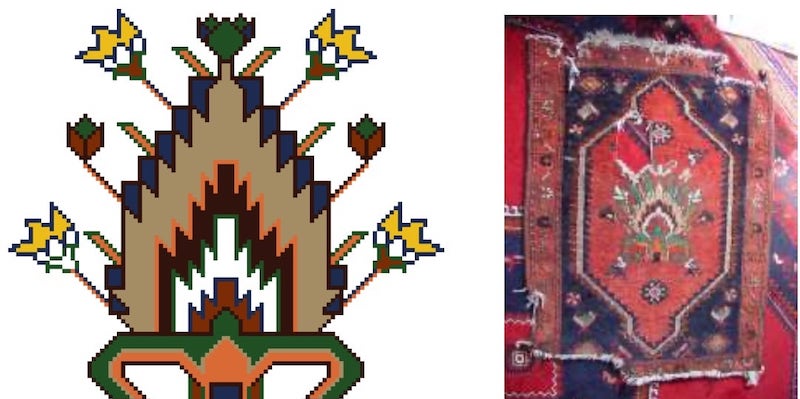
Generally, most of the Kelardasht designs are not complete and we can easily separate them.
6-4- Color of Kelardasht carpet
Color in the field is red and in the margin is dark blue. However in the old carpets, white color as an important color was a custom. Red, dark blue, green, black, orange, brown, blue-white, and light blue are ten colors in Kelardasht carpets. Brown, black, white, light brown are real colors and they are used in the most carpets in this area. According to the people’s beliefs, dark blue shows sadness. Kurds were exiled many years ago to this area so they used dark blue in their carpets. Some say, this colour shows mother love that a woman weaver used in the carpet. Red color represents woman’s love to her family and some say this color shows blood and Kurds bravery.
Acknowledgments
Writers of this article would like to thank research vice president of Najafabad Azad University. We also thank Touraj Zhoule and Reza Alah Dad who helped us to gather authentic data about Kelardasht carpet.
REFERENCES
1-F. Kavoosi “Beauty in Carpet Warp and Woof, The Memorial of Carpet weaver’s Skillful Hand”, Hamvelayatti Newspaper, third year, No220. P: 6.
2-A. Malekpour, “Kelardasht (Geography, History and culture)”, Karafarinan Publication, Second impression, Tehran, 1378, PP: 1-5.
3-F. Mircheraghi. “Kelardasht Tourism”, Azadandishan Publication, Tehran, 1379, PP: 3,9,13.
4-A. jafari “Geography of Iran” Vol3, Amir Press, Tehran, 1379, P: 829.
5-ZH. Mottahedin, “Small Encyclopedia of Iran”, Ghos Publication, Tehran, 1381, P: 183.
6-Dehkoda Dictionary, Second Narration, CD. Tehran University Press, 1380, Following the words of Kelardasht and Div.
7-M. Moin, “Mion Persian Dictionary”, V ol5 , Amirkabir Publication, Tehran, 1377, P: 1078 & 284.
8-M. Keyhan, “Natural Geography”, Amirkabir Publication, Tehran, 1311, PP: 38 & 284.
9-S.A. Mirnia, “Kurdish Clans and Tribes in Iran”, Training Institute Publication and Nasle Danesh Publication, Tehran, 1365, P: 15.
10-S. Amanollahi Baharvand, “Nomadism in Iran”, Translation Agency Publication and Nashre Ketab, Tehran, 1360, P: 203.
11-T. Zhoole, “A research on Iranian carpet”, Yaslavi Publication, first Impression, Tehran, 1381, P: 86.
12-Sh. Souresrafil & T.Zhoole, “Familiarity with Iranian and world Carpet Designs (2)”, shaghayegh Roosta Art-Cultural Institute, first Impression, 1378, P: 148.
13-A. Eshnaberz, Translated by M. Tavalaei, M.R. Nasiri, “Iranian Civic and Rural Carpets”, Farhangsara Publication, Tehran 1374, PP: 134-135.
14-M. Samizade, “Kelardasht Carpet”, Farsh Quarterly Periodical, Iran Carpet Stock Company.
15-H. Kh. Mojabi, “The Geographical Evolution of Kelardasht Carpet Weaving for Reviving it”, Final Report of Research project of Research Assistance of Islamic Azad University, Najafabad Branch, third Chapter, PP:88-102.
16-S.A. Mojabi, “The Geography of Weave, Design and the Role of Kelardasht Carpet”, research week, 1386, Islamic Azad University of Najafabad, PP: 492-520.
17-S. B. Abedini, “Reviving and Examining Kelardasht Designs and Images”, B.A degree, Ardakan Carpet Faculty, 1386, PP: 11-14.
18-S.A. Mojabi, S.B. Abedini & Z. Fanaei, “Classification of Kelardasht Designs and Images”, Goljam Research-Scientific Quarterly Periodical, 1386, fall, PP: 8-21.



